Nature Explorers, initiated in 2016 by Pottsville Community Preschool educators, emerged out of a desire to create a nature-based program for children. It began as a pilot program involving eight families and rapidly expanded due to its success. We now engage with 124 families, benefiting children aged 1 to 12 years across various settings including playgroups at multiple sites, groups for preschoolers, and a program for primary school students.
Playgroups are a wonderful way for young families to make connections in their community and expand their social network, while giving their children opportunities to socialise and to learn through play. These meet ups are also an opportunity to develop children’s social and emotional skills. Supported playgroups allow families to experience peer support and scaffolding from knowledgeable facilitators, increasing parents and carer’s understanding, skill and confidence in supporting their children's development. (Armstrong, Paskal, Elliott, Wray, Davidson, Mizen, and Girdler, 2019)
The power of documentation for championing the value of play
During each session, we have two hours to connect and collaborate with children and their families, giving us the unique opportunity to make children’s learning visible to their families while it’s happening. We then follow this up with a short movie, made up of photos and video from the session, and include a commentary of what learning is happening, or how a particular experience might be positively impacting children's social or emotional wellbeing.
As an early childhood teacher, I see documentation as one of the most powerful resources we have for revealing to families the learning that happens for children during play. And, for this reason, I see documentation as one of the most powerful tools we have for protecting children’s play in the early years and beyond. This practice of documentation in real-time can provide the opportunity to fundamentally shift family perspectives on children’s play. It also provides a platform to change the way parents and carers engage with their children, and to broaden what they see when they watch their children play. This may help them to recognise other high-quality early education settings in the future.

The physical and mental benefits of outdoor play
Spending time outdoors and connecting in nature activates our parasympathetic nervous system, which slows our heart and breathing rates and lowers our blood pressure. This activation improves both physical and mental health by promoting digestion, relaxing our bodies and reducing anxiety (Farrow & Washburn, 2019). When we meet in nature, we are generally in a calmer mindset. When the adults are calmer, we can more easily co-regulate with children in our care, and with each other (Siegel & Bryson, 2011). When children are calmer, there is less time spent supporting children’s behaviour, which leaves more space for children and their families to play and experience connection with each other and the wider group.
The extra space that comes from meeting outdoors gives children more agency over their own group sizes because there are more spaces to congregate, or to take time out. When we meet outdoors with minimal prepared resources, our resources become the natural items and landscapes that we find in the environment. These resources tend to be open ended and abundant, which inspires creativity and imaginative play, and It illustrates to families that toys are not always necessary.
The abundance of resources makes sharing and turn taking less of an issue, which means that the acquisition of these skills, for very young children, can be achieved more intentionally, rather than it being the primary focus of the play session.
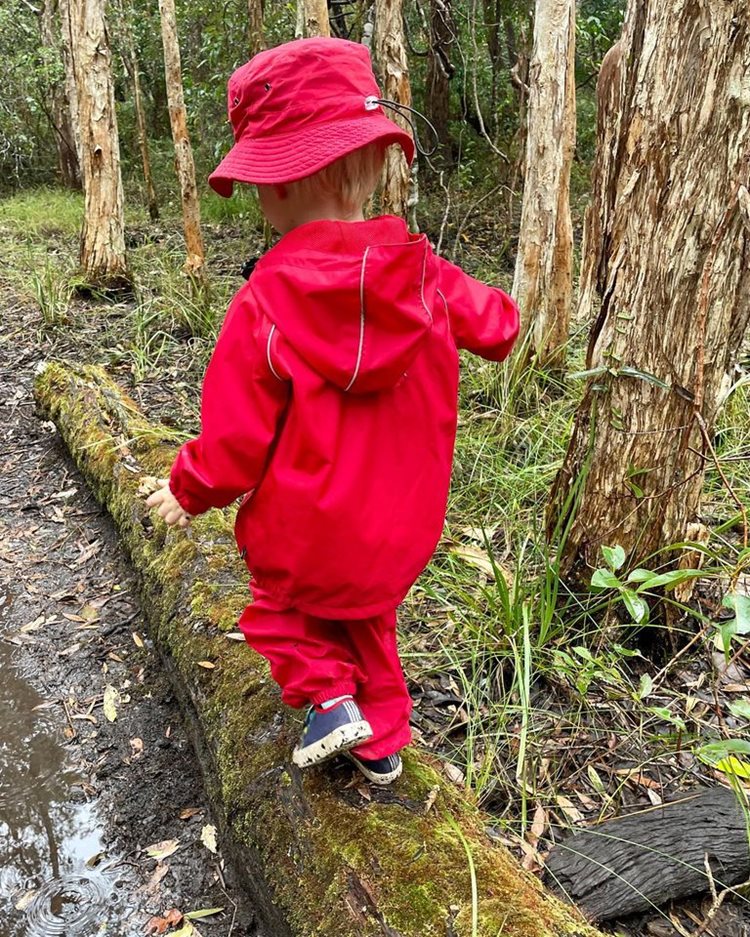
When bush schools use multiple sites
For our Nature Explorers Playgroups, we use multiple bush and beach sites on the Tweed Coast, which gives our children a diverse range of natural landscapes, flora and fauna to experience and learn about.
Beach sites offer the challenges and experience of rock climbing and tide changes, navigating oyster shells, exploring the wildlife in rockpools, and endless opportunities for mark-making and collage in the sand.
Bush sites offer the challenges and experience of bush walking on uneven terrain, tree climbing, weaving and building shelters. Outdoor settings such as these facilitate risky play, which we know promotes increased physical activity and well-being, and builds children’s social competencies, resilience and their abilities to assess risks for themselves. (Obee, Sandseter, and Harper, 2021)
Based on feedback from families, we know that using multiple sites for our playgroups also provides much needed novelty for parents and carers. Rotating through our dedicated sites and returning to each site two weeks in a row, gives children the opportunity to return to their play, and build a sense of belonging to these spaces.
By using multiple sites, young families can discover many new outdoor spaces that work well with young children, and that they can return to at any time to enjoy. This is true for new families only just beginning to explore the shire, as well as for families familiar to the area who may be seeking child-friendly outdoor spaces for the first time.
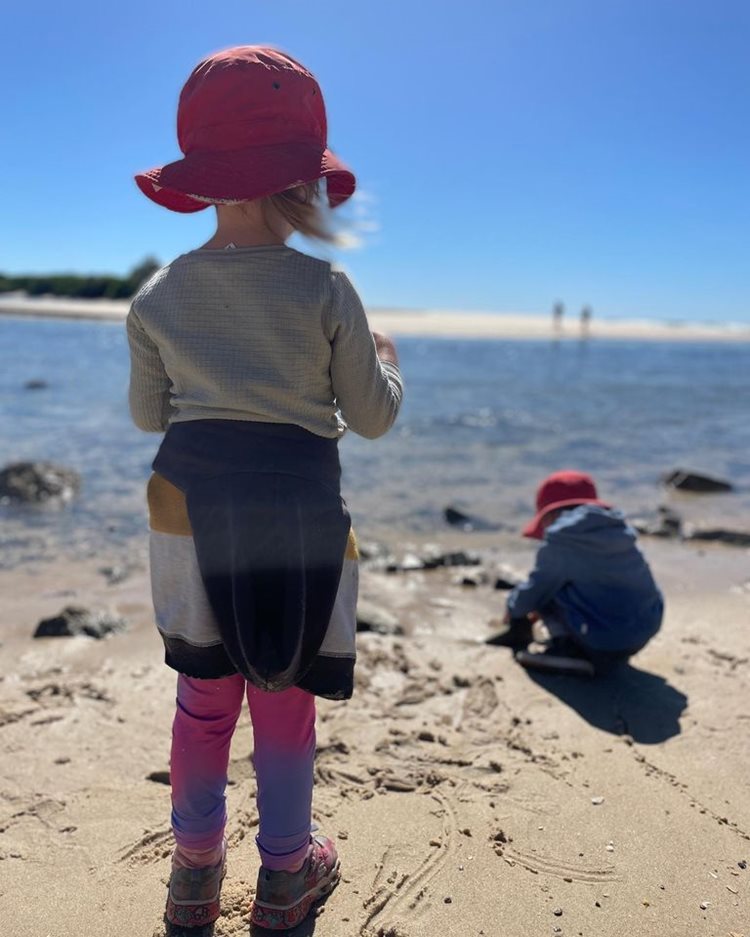
Following the seasons
At Nature Explorers, we follow the Seasons Calendar, which was developed by the Tweed Byron Local Aboriginal Land Council, in collaboration with Tweed Regional Museum. In collaboration with the local Aboriginal community, this six seasons cultural calendar uses cultural knowledge to represent seasonal markers throughout the year. At playgroup, we seek out these seasonal markers at our various bush and beach sites and acknowledge them to children and their families within this context.
The cultural calendar is adaptive and responsive, not constrained by days or months. Changes of season are influenced by rainfall and temperature and the behaviour of plants and animals, rather than by specific dates, and so may vary from year to year - Tweed Museum
(Source: https://museum.tweed.nsw.gov.au/explore/aboriginal-cultural-heritage/seasons-calendar)
This year we have been making journey sticks for one particular bush walk, and have used our documentation to start a photo gallery that shows how this bushwalk changes through the seasons. Local First Nations Peoples have used journey sticks to track their travels, to prompt the retelling of their journey upon return, and also as a way to navigate the trip in the future.
In playgroup, we reference the Goodjinburra Clan of the Bundjalung Nation, who used journey sticks to map their journeys from Fingal Head to Ballina. On a bush walk during Guyumbu (Mullet Season), we used string to bind the things that we found on the ground, including some seasonal markers, to sticks, or pieces bark, to create our own journey sticks. We then returned to the same site during Gagabalingu (Goanna Season), to see how our Journey sticks might have changed with the seasons.
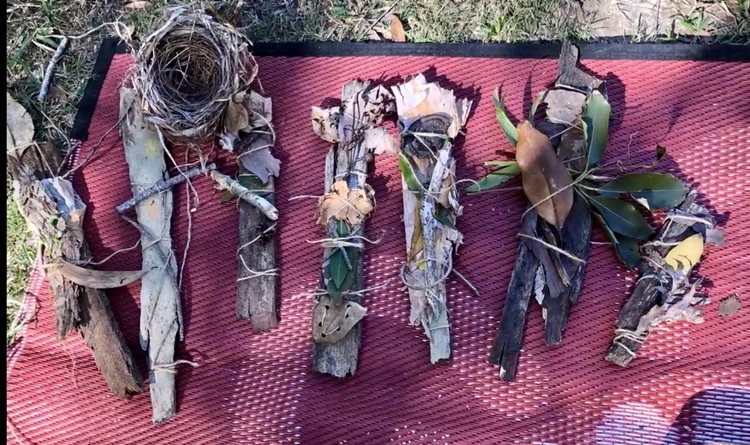
Image features journey sticks made during Mullet Season
Fostering a love of nature and a connection to the land
We believe that a curriculum that evolves in nature intrinsically fosters a love of nature, and a connection to the land. Physicist and systems theorist Fritjof Capra suggests that when children learn about nature and begin to understand their own connection to the ecological systems around them, they are more likely to grow up with a sense of responsibility to these systems (Capra & Luisi, 2014). When we frequently meet in nature, and we slow down and make space for curiosity and exploration, we allow children the opportunity to notice these ecosystems, fostering the beginnings of these connections.
When we spend time in nature, our perceived value for connectedness to nature increases. This, in turn, grows greater intrinsic pro-environmental attitudes in young children (and adults), as opposed to seemingly arbitrary values, guided by extrinsic motivation (Ryfield, Cabana, Brannigan, & Crowe, 2019). One could argue that this reframes our work in playgroup as grass-roots environmental advocacy work, contributing to the development of more sustainable communities in the future. Admittedly, these are lofty goals, but at Nature Explorers, we like to think globally, and act locally.
The images below are from a nature scavenger hunt:
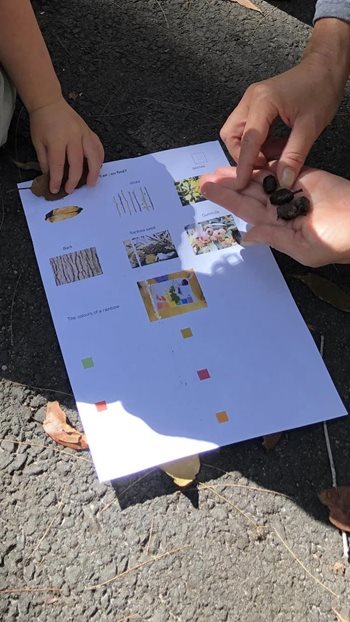
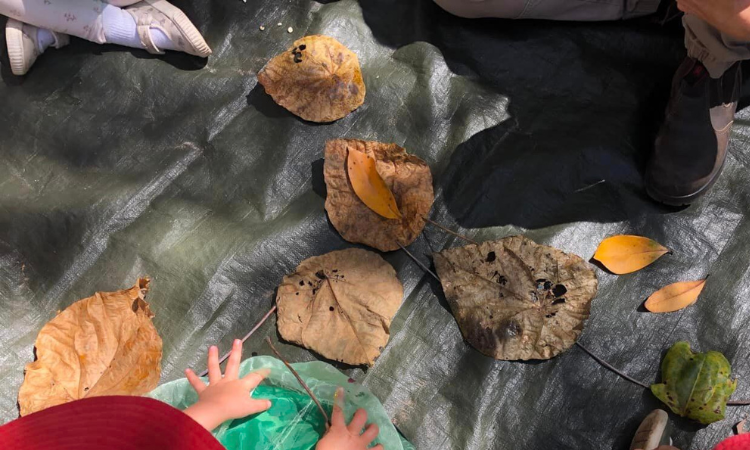
You can find more images from Nature Explorers via their Instagram page
Thank you to Catherine Underwood for sharing her reflection with Amplify! readers.

References
Armstrong, J., Paskal, K., Elliott, C., Wray, J., Davidson, E., Mizen, J., & Girdler, S. (2019). What makes playgroups therapeutic? A scoping review to identify the active ingredients of therapeutic and supported playgroups. Scandinavian Journal of Occupational Therapy, 26(2), 81-102.
Siegel, D. J., & Bryson, T. P. (2011). The whole-brain child. London: Constable & Robinson.
Farrow, M. R., & Washburn, K. (2019). A review of field experiments on the effect of forest bathing on anxiety and heart rate variability. Global advances in health and medicine, 8, 2164956119848654.
Obee, P., Sandseter, E. B. H., & Harper, N. J. (2021). Children’s use of environmental features affording risky play in early childhood education and care. Early Child Development and Care, 191(16), 2607-2625.
Ryfield, F., Cabana, D., Brannigan, J., & Crowe, T. (2019). Conceptualizing ‘sense of place’in cultural ecosystem services: A framework for interdisciplinary research. Ecosystem Services, 36, 100907.
Capra, F., & Luisi, P. L. (2014). The systems view of life: A unifying vision. Cambridge University Press.